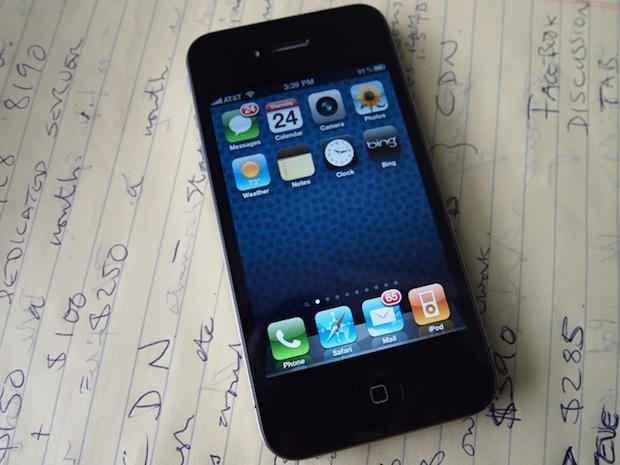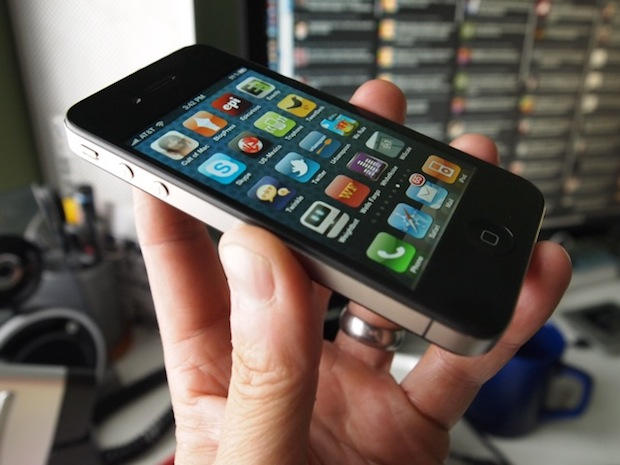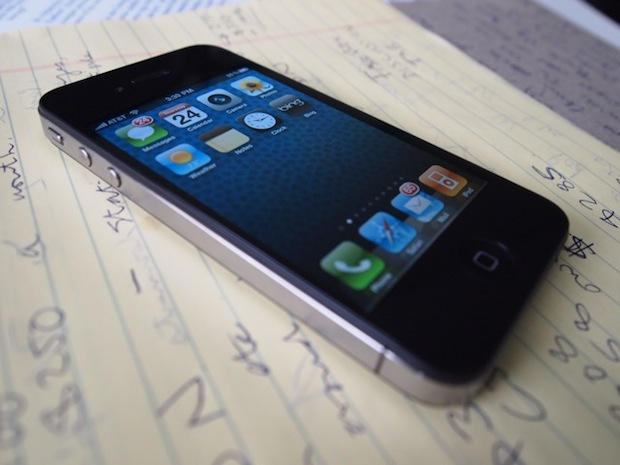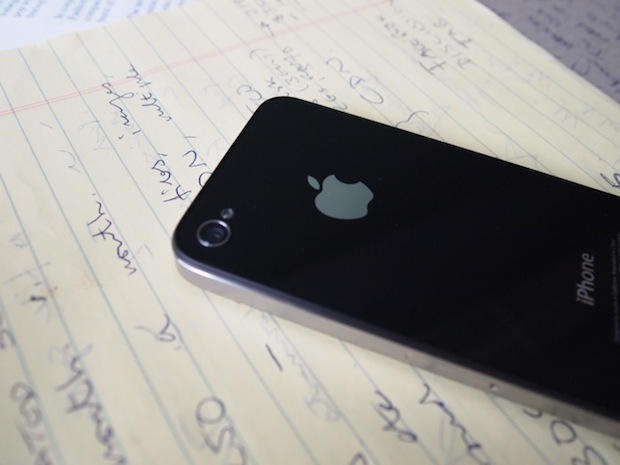You’re probably sick of reading about the iPhone 4, so here it is in a nutshell: It’s slick as sh*t and I recommend without hesitation that you buy it.
- No yellow spots
- Holding it the “wrong way” drops bars, but it doesn’t matter much to performance.
- It doesn’t scratch that easily, no matter what you’ve read.
- Industrial design is beautiful.
- The screen is gorgeous: like going from SD to HD.
- Photos and video are much improved.

I stood in line for four-and-a-half hours this morning to get the iPhone 4. I wasn’t as excited as I was at the 3GS launch last year, but this phone has really grown on me. I love it.
Combined with the iOS 4 update, this is one sweet pocket computer/entertainment powerhouse. It’s beautifully made: the Aston Martin of gadgets. FaceTime videoconferencing is fun. It takes much better pictures and video. It’s also gotten better at making phone calls.
The Screen
The 326-pixels-per-inch Retina display is like moving from a standard-def TV to HD. By comparison, an old iPhone 3GS screen looks like shit. This is funny because I never noticed it before. A high-res iPhone screen wasn’t on anyone’s wish list, but once you see the Retina display, you can’t go back. It’s very crisp and clear, especially when displaying text.
Industrial Design
The industrial design is superb. The iPhone 4 is probably Apple’s best device yet. Made from two slabs of hardened glass, wrapped in stainless steel, the phone has significant heft and weight. The glass and metal feel so much more substantial and classier than the old plastic models. It makes older iPhones look old-fashioned and dated, like old see-through iMacs.
That Jonny Ive managed to cram in a beefier battery (16 percent bigger), a faster processor, a gyroscope and a pair of cameras into this thinner, sleeker case is a testament to the man’s extraordinary design chops. The buttons are nicely set and respond with a satisfying click.
Engadget reported that the iPhone’s glass scratches easily, but mine is still spotless despite taking a couple of falls. No, it hasn’t been in the same pocket as my keys, but the glass feels as sturdy as the glass on the 3GS, which has stood up amazingly well to a year’s abuse.
The microphone is now noise-reducing, and the speaker is louder and clearer. This is evident the first time the phone rings — it’s noticeably louder. Calls on the speaker phone seem more audible. The earpiece seems to be louder too, but this may be my imagination.
The iPhone sports the new A4 chip, the same used in the iPad, and the speed is awesome. This is one whippy device. The 3GS was no slouch, but the iPhone 4 is almost instantaneous in all its functions, especially the camera. There’s no lag in typing — a problem that sometimes drove me crazy on the 3GS.
The Antenna Death Grip
The “Death Grip” that drops bars when you wrap your fingers around the lower antenna is real, but it may not have much effect on performance. It’s not the number of bars that count, says tech expert Ted Landau, but the decibels per milliwatt (dBm). “FWIW, the number of bars on my iPhone vary a lot — depending on how I hold phone — but actually dbms stay within about 10 unit range,” he said on Twitter. (To see dBm on older iPhones — it doesn’t work in iOS 4 — type *3001#12345#* in the Phone app’s Keypad screen and tap Call button. The dBm appears where bars were. Tap to toggle.)
FaceTime and Front-Facing Camera
Apple’s FaceTime videoconferencing is elegant and cool but I’m skeptical that it’s anything but a novelty. Launching FaceTime is a one-button affair. There’s no setup and no configuration. If the other party also has an iPhone 4 (and is on a Wi-Fi network), you hit the FaceTime button and you’re quickly connected. Admittedly, I had a lot of problems initially connecting to my old buddies at Wired.com, and they with me. Whatever the issues were, they eventually resolved and when we did connect we were laughing our heads off at the kick of it. It’s a ton of fun.
But I suspect the novelty will soon wear off. I can’t see people using it for day-to-day communication. The best thing about ordinary telephone calls is you can surf the web or watch TV while also conducting a conversation. You can’t do that with FaceTime, and I think that will be a problem. In addition, I’ve had a FaceTime system on my computers for a couple of years now (iChat and iSight) and rarely use it. Neither does anyone else I know.
5-Megapixel Camera
The 5-megapixel camera is no DSLR, but it does rival a low- to mid-range point-and-shoot snappers. Pictures are pretty good, if a little washed out. Snapping pictures is instantaneous; there’s no infuriating lag. The extra speed also means less blur, which is especially handy for fast-moving subjects like my kids.
On the back there’s a bright little LED flash that’s surprisingly functional (see the under-the-sink snap below). It looks especially handy for illuminating low-light video shoots, Blair Witch-style.
The new camera shoots video at 720p HD resolution. In my quick tests, the video looked pretty good. I’ll report back later when I’ve had a chance to put it through its paces. A comparison by iLounge shows it rivals video from a HD Flip camcorder.
I recommend the iPhone 4 without reservation, even with the ‘Death Grip’ antenna issue, which initially freaked me out, but now looks like no big deal.
Sample Pictures:
These aren’t the greatest pictures, but the camera is comparable to a low- to mid-range point-and-shoot. And like they say, the best camera is the one you have on you…
The colors are washed out, but it was a typical summer day in San Francisco: gloomy.
Using the built-in flash:
![IPhone 4 Lives Up To The Hype [Review] P6241073](https://www.cultofmac.com/wp-content/uploads/2010/06/P6241073.jpg)










